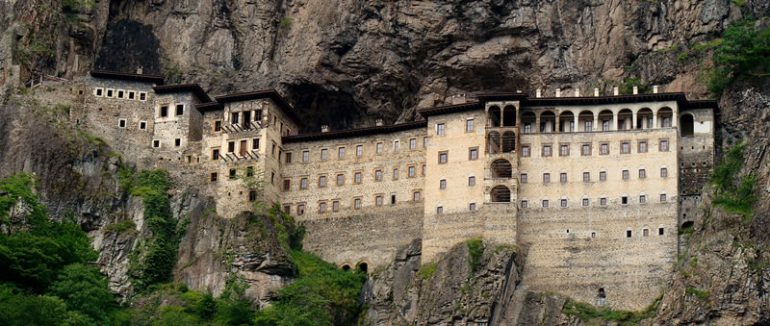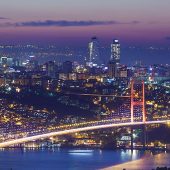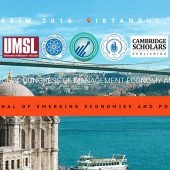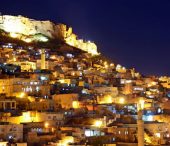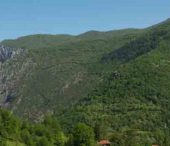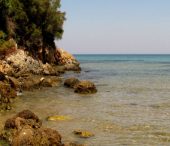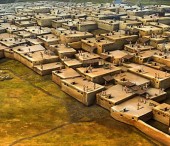General Information
İn Turkish: Sümela Manastırı; Panagia Soumela, "Virgin Mary of Soumela" in Greek is a spectacular rock-hewn monastery perched dramatically on the narrow ledge of a steep cliff in the forests south of Trabzon. It was built in the fourth century, just before the Roman Empire split into east and west, by two Athenian priests, Barnabas and Sophronius, who, according to legend, found a miraculous icon of the Virgin Mary in a cave. The monastery's location in this geopolitically tumultuous corner of the globe naturally saw times of trouble and fell into ruin numerous times throughout its history, with its most thriving times falling under Byzantine and Ottoman rule.
The twentieth century, however, was not kind to the monastery. It was abandoned following the chaos and inter-ethnic violence at the end of World War I, and the population transfer of Trabzon's (formerly Trebizond) Greek population back to Greece. Its remote location gave it some sanctuary, but its frescoes still attracted the occasional casually hurled rock by a bored shepherd. The beautiful frescoes today suffer from decades of heart-wrenchingly pointless vandalism by travelers—judging from the various alphabets and names scrawled across these impressive religious works of art, it appears that just about every culture in the world has taken part in the desecration. The buildings themselves have been fairly heavily restored in recent decades, as the Turkish government has stepped in to protect the monastery and to turn it into a museum.
The simplest way to get to the monastery is by tour, and you can find a tour in town by just asking any other traveler there (no tourist visits Trabzon without seeing Sümela). The monastery lies close to Maçka, about 30 km south of Trabzon, and those preferring to get to the monastery on their own means instead of taking a tour can get to Maçka by taking minibuses heading for Gümüşhane, Erzurum or other destinations south from Trabzon. The rest of the way, approximately 17 km to the actual site of monastery, can be done by dolmuşes from downtown Maçka, which will take you to the entrance of Altındere National Park (Milli Park). Then, the monastery is about half an hour walk away, which can be done through a forest trail, which was recently widened in order to cope with the ever increasing numbers of visitors, or along the tarmac road leading to the monastery. Those approaching with their own vehicles can get as near as 300 meters to Sümela itself, where there is a car-park in front of Hagia Barbara Chapel.
Today the monastery's primary function is as a tourist attraction. It overlooks forests and streams, making it extremely popular for its aesthetic attraction as well as for its cultural and religious significance.
History
The monastery was founded in 386 AD during the reign of the Emperor Theodosius I (375 - 395), Legend has it that two priests undertook its creation after discovering a miraculous icon of the Virgin Mary in a cave on the mountain.
During its long history, the monastery fell into ruin several times and was restored by various emperors. During the 6th century, it was restored and enlarged by General Belisarius at the behest of Justinian.
It reached its present form in the 13th century after gaining prominence during the reign of Alexios III (1349 - 1390) of the Komnenian Empire of Trebizond, established in 1204. At that time, the monastery was granted an amount annually from imperial funds. During the time of Manuel III, son of Alexius III, and during the reigns of subsequent princes, Sümela gained further wealth from imperial grants. Following the conquest by theOttoman Sultan Mehmed II in 1461, it was granted the sultan's protection and given rights and privileges that were renewed by following sultans. The monastery remained a popular destination for monks and travelers through the years.
In 1682 and for a few decades, the monastery housed the Phrontisterion of Trapezous, a well-known Greek educational institution of the region.
The monastery was seized by the Russian Empire during the 1916-18 occupation of Trabzon.
The site was abandoned in 1923, following forced population exchanges between Greece and Turkey. The departing monks were not allowed to take any property with them, so they buried Sumela's famous icon under the floor of the monastery's St. Barbara chapel. In 1930, a monk secretly returned to Sumela and retrieved the icon, transferring it to the new Panagia Soumela Monastery, on the slopes of Mount Vermion, near the town of Naousa, in Macedonia, Greece.
Today the monastery's primary function is as a tourist attraction. It overlooks forests and streams, making it extremely popular for its aesthetic attraction as well as for its cultural and religious significance.
As of 2012, the Turkish government is funding restoration work, and the monastery is enjoying a revival in pilgrimage from Greece and Russia.
On 15 August 2010, Orthodox divine liturgy was allowed to take place in the monastery compound. A special pass issued by the Ecumenical Patriarchate of Constantinople is now required to visit on August 15, the day of the Dormition of the Theotokos or Feast of the Assumption, when a divine liturgy is held. Only 450 to 500 visitors are allowed inside the monastery, although widescreen televisions are available to observe the event at a cafe some hundred metres away from the monastery.
The principal elements of the Monastery complex are the Rock Church, several chapels, kitchens, student rooms, a guesthouse, a library, and a sacred spring revered by Eastern Orthodox Christians.
The large aqueduct at the entrance, which supplied water to the Monastery, is constructed against the side of the cliff. The aqueduct has many arches which have mostly been restored. The entrance to the Monastery leads up a long and narrow stairway. There is a guard-room next to the entrance. The stairs lead down from there to the inner courtyard. On the left, in front of a cave, there are several monastery buildings. The cave, which was converted into a church, constitutes the centre of the monastery. The library is to the right.
The large building with a balcony on the front part of the cliff was used for the monks' cells and for housing guests. It dates from 1840.
The influence of Turkish art can be observed in the design of the cupboards, niches and fireplace in the rooms of the buildings surrounding the courtyard.
The inner and outer walls of the Rock Church and the walls of the adjacent chapel are decorated with frescoes. Frescoes dating from the era ofAlexios III of Trebizond line the inner wall of the Rock Church facing the courtyard. The frescoes of the chapel which were painted on three levels in three different periods are dated to the beginning of the 18th century. The frescoes of the bottom band are of superior quality.
The frescoes of the Sümela Monastery are seriously damaged. The main subject of the frescoes are biblical scenes telling the story of Christ and the Virgin Mary.
Places of interest
Besides Sümela Monastery you can visit some other historical places which are situated in Trabzon region:
The Church of Saint Sophia (Greek: Ἁγία Σοφία, meaning "Holy Wisdom" Turkish: Ayasofya), now the Saint Sophia Museum, is a former Chalcedonian (Greek Orthodox) church located in the city of Trabzon in the north-eastern part of Turkey. It dates back to the thirteenth century when Trabzon was the capital of the Empire of Trebizond. It is located near the seashore and two miles west of the medieval town's limits. It is one of a few dozen Byzantine sites still existent in the area.
Uzungöl, a lake up in the mountains 99 km from Trabzon, 19 km. from Caykara and at an altitude of 1090 m. A great number of broken rocks from the slopes filled up Haldizen stream and Uzungöl was formed in this way. The lake is 1000 m long, 500 m in width and 15 m in depth.
How can i get there?
Air
By daily planes from Ankara,Istanbul and Izmir. There are also planes from Adana Pegasus Airlines) and Bursa(Borajet), as well as scheduled international flights from certain European and regional cities.
Bus
By bus from all major cities in Turkey. From Istanbul (65 TL, 18 hrs) they depart several times per day. From Kayseri it's 12hrs. There are also buses from Tbilisi, Georgia (about 12 hours) which serve as a useful point of entry to the country from Caucasus. There will be a "servis" (free shuttle bus) from the bus station to the city centre.
Source: http://goturkey.com/

